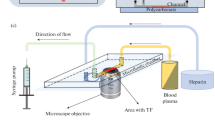Abstract
It was found that the enzymes of the coagulation cascade interact with lipid microparticles or microvesicles of natural or artificial origin that circulate in the blood. Such interactions can modulate hemostasis. Less is known about the consequences of direct interaction of fibrinogen/fibrin with microvesicles. It was shown in this study with purified systems that the presence of lipid particles of various compositions in a solution can specifically affect the kinetics of fibrin polymerization. Experimental data are presented that indicate that these effects are due to the adsorption of fibrinogen on the surface of microvesicles. In particular, it was shown that the adsorption of fibrinogen at a sufficiently high concentration led to an acceleration of thrombin-induced fibrin polymerization due to the local concentrating effect and the inclusion of microvesicles in the clot structure. Thus, the direct interaction of fibrinogen with microvesicles is a significant factor of hemostasis, which should be considered in the analysis of blood clotting disorders and the development of artificial lipid carriers of drugs.






Similar content being viewed by others
REFERENCES
R. M. Nabiullina, D. A. Faizullin, C. Nagaswami, et al., Blood 124, 2807 (2014).
R. M. Nabiullina, I. G. Mustafin, Y. F. Zuev, et al., Dokl. Biochem. Biophys. 462 (1), 151 (2015).
L. D. Zubairova, R. M. Nabiullina, C. Nagaswami, et al., Sci. Rep. 5, 1 (2015).
M. T. Cunningham, B. A. Citron, and T. A. Koerner, Thrombosis Res. 95, 325 (1999).
B. Varadi, K. Kolev, K. Tenekedjiev, et al., J. Biol. Chem. 279, 39863 (2004).
D. R. Bakirova, D. A. Faizullin, Yu. A. Valiullina, et al., Bull. Exp Biool. Med. 163 (6), 722 (2017).
A. M. Galan, M. R. Hernandez, J. Bozzo, et al., Transfusion 38 (11–12), 1004 (1998).
B. Alving, Transfusion 38 (11–12), 997 (1998).
M. R. Hernandez, P. Urban, E. Casals, et al., Int. J. Nanomed. 7, 2339 (2012).
N. Amabile, C. Guignabert, D. Montani, et al., Eur. Respir. J. 42 (1), 272 (2013).
F. Kunz, W. D. Zwierzina, and H. Hortnagl, Atherosclerosis 49 (2), 195 (1983).
M. F. Matus, C. Vilos, B. A. Cisterna, et al., Vasc. Pharmacol. 101, 1 (2018).
A. S. Jakate, C. M. Einhaus, A. P. DeAnglis et al., Cancer Res. 63 (21), 7314 (2003).
A. Tanka-Salamon, A. Bota, A. Wacha, et al., BioMed Res. Int. 2017, 5130495 (2017).
Y. Hu, C. Wu, C. Zhu, et al., Int. J. Pharm. 552, 319 (2018).
M. Shukla, U. D. Sekhon, V. Betapudi, et al., J. Thromb. Haemost. 15 (2), 375 (2017).
Yu. F. Zuev, R. I. Litvinov, A. E. Sitnitsky, et al., J. Phys. Chem. B 121, 7833 (2017).
T. Ueda, D. Murakami, and M. Tanaka, Front. Chem. 6, 542 (2018).
K. Sankaranarayanan, Biointerphases 10, 021009 (2015).
B. C. Cook and G. S. Retzinger, J. Colloid Interface Sci. 162 (1), 171 (1994).
G. S. Retzinger, B. C. Cook, and A. P. DeAnglis, J. Colloid Interface Sci. 168, 514 (1994).
Z. Adamczyk, J. Barbasz, and M. Cieśla, Langmuir 27, 6868 (2011).
L. Zhang, B. Casey, D. K. Galanakis, et al., Acta Biomater. 54, 164 (2017).
J. W. Weisel and C. Nagaswami, Biophys. J. 63, 111 (1992).
T. Sugo, H. Endo, M. Matsuda, et al., J. Thromb. Haemost. 4, 1738 (2006).
J. W. Weisel and R. I. Litvinov, Cardiovasc. Hematol. Agents Med. Chem. 6, 161 (2008).
A. I. Greenwood, S. Tristram-Nagle, and J. F. Nagle, Chem. Phys. Lipid. 143 (1–2), 1 (2006).
Y. Okahata and H. Ebato, Anal. Chem. 63, 203 (1991).
S. R. Tabaei, J.-H. Choi, G. H. Zan, et al., Langmuir 30 (34), 10363 (2014).
R. R. Hantgan and J. Hermans, J. Biol. Chem. 254, 11272 (1979).
P. T. T. Wong, D. J. Siminovitch, and H. H. Mantsch, Biochim. Biophys. Acta 947, 139 (1988).
F. M. Goni and J. L. Arrondo, Faraday Discuss. Chem. Soc. 81, 117 (1986).
T. Shimanouchi, M. Sasaki, A. Hiroiwa, et al., Colloids Surf. B: Biointerfaces 88, 221 (2011).
S. J. Hug, J. Colloid Interface Sci. 188, 415 (1997).
K. Glasmastar, C. Larsson, F. Hook, and B. Kasemo, J. Colloid Interface Sci. 246 (1), 40 (2002).
R. Koynova and B. Tenchov, in Wiley Encyclopedia of Chemical Biology (Wiley, Hoboken, NJ, 2009), Vol. 2, pp. 601–615.
P. Jia, M. He, Y. Gong, et al., ACS Appl. Mater. Interfaces 7 (12), 6422 (2015).
T. Nezu, M. Taira, S. Saitoh, et al., Int. J. Biol. Macromol. 46 (4), 396 (2010).
S. R. Baker and R. A. S. Ariens, in Cardiovascular Thrombus, Ed. by O. Topaz (Academic, London, 2018), pp. 31–49.
ACKNOWLEDGMENTS
Studies using scanning electron microscopy were performed at the Interdisciplinary Center Analytical Microscopy of Kazan Federal University (Kazan).
Funding
The work was performed under State assignment of FRC KazSC RAS.
Author information
Authors and Affiliations
Corresponding author
Ethics declarations
CONFLICT OF INTEREST
The authors declare that there is no conflict of interest.
COMPLIANCE WITH ETHICAL STANDARDS
This paper does not describe studies using humans and animals as objects.
Additional information
Translated by E. Puchkov
Abbreviations: DPPC, 1,2-dipalmitoyl-sn-glycero-3-phosphocholine; POPG, 1-palmitoyl-2-oleoyl-sn-glycero-3-phospho-(1'-rac-glycerol); POPC, 1-palmitoyl-2-oleoyl-sn-glycero-3-phosphocholine.
Rights and permissions
About this article
Cite this article
Faizullin, D.A., Valiullina, Y.A., Salnikov, V.V. et al. Fibrinogen Adsorption on the Lipid Surface as a Factor of Regulation of Fibrin Formation. BIOPHYSICS 66, 70–76 (2021). https://doi.org/10.1134/S0006350921010103
Received:
Revised:
Accepted:
Published:
Issue Date:
DOI: https://doi.org/10.1134/S0006350921010103




